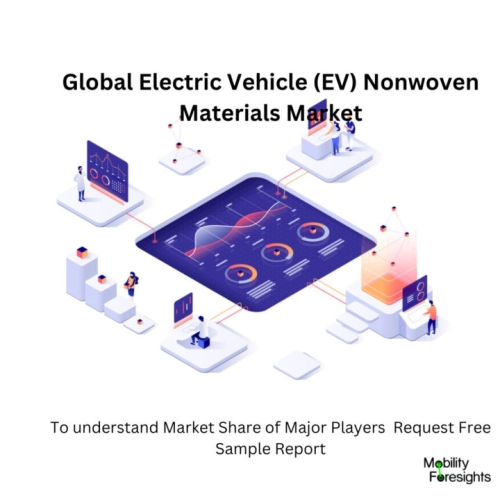
- Get in Touch with Us

Last Updated: Apr 25, 2025 | Study Period: 2024-2030
Electric vehicles (EVs) are made with the help of nonwoven materials, which offer components that are lightweight, strong, and useful. These materials serve as filtration, noise reduction, insulation, and other functions in various EV parts. For insulation purposes, the battery packs of electric vehicles use nonwoven materials.
They aid in controlling and maintaining the battery cells' operating temperature, assuring their performance and safety. Nonwovens can aid to uniformly transfer heat, offer thermal insulation, and stop overheating.
Nonwoven materials are frequently employed for interior parts like upholstery, carpeting, and headliners. They provide sound absorption and can make the interior quieter, which is crucial in electric vehicles because there is less engine noise to cover up other noises.

The Global Electric vehicle (EV) nonwoven materials market accounted for $XX Billion in 2023 and is anticipated to reach $XX Billion by 2030, registering a CAGR of XX% from 2024 to 2030.
Vehicles can be made lighter, more environmentally friendly, and more comfortable due to new technologies from nonwovens producers and converters. Nonwovens are assisting auto designers in addressing the demand for lightweight, affordable, environmentally friendly materials that boost driver and passenger comfort while reducing noise.
Because of their adaptability and versatility in new applications, nonwovens are indeed playing a larger role in society.
An excellent sound absorber can also be a good thermal insulator due to nonwovens' ability to integrate many qualities into a single fabric. Nonwovens are also capable of serving several purposes. For instance, flat sheets can be used as sound-absorbing pads. They can also be formed into two- or three-dimensional objects using dies or die-cutting machines.
The Nissan design team has increased the amount of nonwoven materials used in some components of the car. Some nonwoven materials have advantages in terms of cost, as well as light weight, low profile, and the capacity to have a visible raw edge (without fraying).
Nissan has enhanced non woven carpet covering in the luggage compartment to encompass the sides of the luggage on more current sports utility vehicles and crossover utility vehicles to reduce scratching and marring and to increase the premium feel.
Nonwoven fabrics have been employed more in styling as part of the ornamentation. However, due to its ease of soiling and cleaning, nonwoven material has been avoided by the automaker as far as possible for door and centre console armrests.
| Sl no | Topic |
| 1 | Market Segmentation |
| 2 | Scope of the report |
| 3 | Abbreviations |
| 4 | Research Methodology |
| 5 | Executive Summary |
| 6 | Introduction |
| 7 | Insights from Industry stakeholders |
| 8 | Cost breakdown of Product by sub-components and average profit margin |
| 9 | Disruptive innovation in the Industry |
| 10 | Technology trends in the Industry |
| 11 | Consumer trends in the industry |
| 12 | Recent Production Milestones |
| 13 | Component Manufacturing in US, EU and China |
| 14 | COVID-19 impact on overall market |
| 15 | COVID-19 impact on Production of components |
| 16 | COVID-19 impact on Point of sale |
| 17 | Market Segmentation, Dynamics and Forecast by Geography, 2024-2030 |
| 18 | Market Segmentation, Dynamics and Forecast by Product Type, 2024-2030 |
| 19 | Market Segmentation, Dynamics and Forecast by Application, 2024-2030 |
| 20 | Market Segmentation, Dynamics and Forecast by End use, 2024-2030 |
| 21 | Product installation rate by OEM, 2023 |
| 22 | Incline/Decline in Average B-2-B selling price in past 5 years |
| 23 | Competition from substitute products |
| 24 | Gross margin and average profitability of suppliers |
| 25 | New product development in past 12 months |
| 26 | M&A in past 12 months |
| 27 | Growth strategy of leading players |
| 28 | Market share of vendors, 2023 |
| 29 | Company Profiles |
| 30 | Unmet needs and opportunity for new suppliers |
| 31 | Conclusion |
| 32 | Appendix |